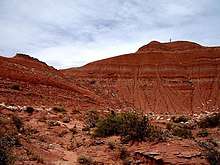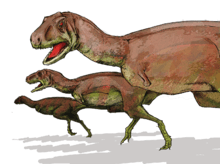Anacleto Formation
| Anacleto Formation Stratigraphic range: Early Campanian ~83–78 Ma | |
|---|---|
 Outcrop of the formation at Auca Mahuida | |
| Type | Geological formation |
| Unit of |
Neuquén Group Río Colorado Subgroup |
| Underlies |
Malargüe Group Allen Formation |
| Overlies | Bajo de la Carpa Formation |
| Thickness | 60–90 m (200–300 ft) |
| Lithology | |
| Primary | Mudstone |
| Other | Sandstone, limestone |
| Location | |
| Location | Patagonia |
| Coordinates | 37°54′S 68°30′W / 37.9°S 68.5°WCoordinates: 37°54′S 68°30′W / 37.9°S 68.5°W |
| Approximate paleocoordinates | 40°48′S 53°00′W / 40.8°S 53.0°W |
| Region | Neuquén, Mendoza & Río Negro Provinces |
| Country |
|
| Extent | Neuquén Basin |
| Type section | |
| Named for | Aguada de Anacleto |
The Anacleto Formation is a geologic formation with outcrops in the Argentine Patagonian provinces of Mendoza, Río Negro, and Neuquén. It is the youngest formation within the Neuquén Group and belongs to the Río Colorado Subgroup. Formerly that subgroup was treated as a formation, and the Anacleto Formation was known as the Anacleto Member.[1]
The type locality of this formation lies 40 kilometres (25 mi) west of the city of Neuquén. At its base, the Anacleto Formation conformably overlies the Bajo de la Carpa Formation, also of the Río Colorado Subgroup, and it is in turn unconformably overlain by the Allen Formation of the younger Malargüe Group.[2]
The Anacleto Formation varies between 60 and 90 metres (200 and 300 ft) thick, and consists mainly of claystones and mudstones, purple and dark red in color, deposited in fluvial, lacustrine and floodplain environments. Geodes are often found scattered throughout this formation.[3]
Age
Era: Mesozoic
Period: Late Cretaceous
Faunal stage: early Campanian
Absolute Age: ~83 to ~78 mya
Paleofauna

Nests of dinosaur eggs, many with preserved embryos inside, have been discovered in large quantities at the famous Auca Mahuevo locality, and have been attributed to titanosaurs.[4]
Known from bones found in the Anacleto Formation are:
- Aerosteon
- several species of lizards
- a peirosaurid metasuchian (Gasparinisuchus)[5]
- an ornithopod (Gasparinisaura)
- titanosaurian sauropods (Antarctosaurus wichmannianus, Pellegrinisaurus, Barrosasaurus, Neuquensaurus)
- ceratosaurian theropods (Abelisaurus, Aucasaurus)
- some other theropod remains
- several species of mammals
The oldest known unequivocal bird footprints from South America were also discovered in the Anacleto Formation. The small footprints were tentatively assigned to the ichnogenus Aquatilavipes and might have been produced by Patagopteryx (whose fossils were only found in the Bajo de la Carpa Formation however) or some unknown wader-like bird; they lack a hind toe. Ignotornis refers to similar footprints made by larger birds with a small hind toe; they might have been left by Neuquenornis, but this is also only known from the Bajo de la Carpa Formation. Footprints of these two ichnogenera have also been found elsewhere, but it must be understood that assignment to the same ichnogenus does not imply a close relatedness of the organisms that produced these traces, only a similar morphology.[6]
Even smaller and somewhat unusual footprints assigned to Barrosopus are only known from the Anacleto Formation. They were almost certainly made by some tiny theropod, but whether this was a bird is not quite clear: the innermost front toes of the animal leaving these tracks attached in a position higher than the others. In that, and in their dimensions, they are a very close match for the odd-footed enantiornithine bird Yungavolucris brevipedalis, but this is only known from the Maastrichtian Lecho Formation which is some 10 million years younger.[7]
See also
References
- ↑ Sánchez et al. (2006)
- ↑ Fossa Mancini et al. (1938), Leanza et al. (2004)
- ↑ Leanza et al. (2004), Sánchez et al. (2006)
- ↑ Salgado et al. (2005), Sánchez et al. (2006)
- ↑ Agustín G. Martinelli; Joseph J.W. Sertich; Alberto C. Garrido; Ángel M. Praderio (2012). "A new peirosaurid from the Upper Cretaceous of Argentina: Implications for specimens referred to Peirosaurus torminni Price (Crocodyliformes: Peirosauridae)". Cretaceous Research. in press. doi:10.1016/j.cretres.2012.03.017.
- ↑ Coria et al. (2002), Lockley et al. (2006)
- ↑ Chiappe (1993), Coria et al. (2002), Lockley et al. (2006)
Bibliography
- Chiappe, Luis M. (1993): Enantiornithine (Aves) Tarsometatarsi from the Cretaceous Lecho Formation of Northwestern Argentina. American Museum Novitates 3083: 1-27. [English with Spanish abstract] PDF fulltext
- Coria, Rodolfo A.; Currie, Philip J.; Eberth, David & Garrido, Alberto (2002): Bird footprints from the Anacleto Formation (Late Cretaceous), Neuquén, Argentina. Ameghiniana 39(4): 453-463. [English with Spanish abstract] PDF fulltext
- Fossa Mancini, E.; Feruglio, E.; Yussen de Campana, J.C. (1938): Una reunión de geólogos de YPF y el problema de la terminología estratigráfica ["A YPF geologists' reunion and the problem of stratigraphy terminology"]. Boletín de Informaciones Petroleras 15: 1-67.
- Leanza, H.A.; Apesteguia, S.; Novas, F.E. & de la Fuente, M.S. (2004): Cretaceous terrestrial beds from the Neuquén Basin (Argentina) and their tetrapod assemblages. Cretaceous Research 25(1): 61-87. doi:10.1016/j.cretres.2003.10.005 (HTML abstract)
- Lockley, Martin; Matsukawa, Masaki; Ohira, Hiroto; Li, Jianjun; Wright, Joanna; White, Diane & Chen, Peiji (2006): Bird tracks from Liaoning Province, China: New insights into avian evolution during the Jurassic-Cretaceous transition. Cretaceous Research 27(1): 33-43. doi:10.1016/j.cretres.2005.10.007 (HTML abstract). Erratum: doi:10.1016/j.cretres.2008.06.002
- Salgado, L.; Coria, R.A. & Chiappe, Luis M. (2005): Osteology of the sauropod embryos from the Upper Cretaceous of Patagonia. Acta Palaeontologica Polonica 50(1): 79–92. PDF fulltext
- Sánchez, Maria Lidia; Heredia, Susana & Calvo, Jorge O. (2006): Paleoambientes sedimentarios del Cretácico Superior de la Formación Plottier (Grupo Neuquén), Departamento Confluencia, Neuquén [Sedimentary paleoenvironments in the Upper Cretaceous Plottier Formation (Neuquen Group), Confluencia, Neuquén]. Revista de la Asociación Geológica Argentina 61(1): 3-18. [Spanish with English abstract] PDF fulltext
Further reading
- S. Brizuela and A. Albino. 2011. A Scincomorpha lizard from the Campanian of Patagonia. Cretaceous Research 32:781-785
- I. A. Cerda. 2008. Gastroliths in an ornithopod dinosaur. Acta Palaeontologica Polonica 53(2):351-355
- L. M. Chiappe, R. A. Coria, L. Dingus, F. Jackson, A. Chinsamy and M. Fox. 1998. Sauropod dinosaur embryos from the Late Cretaceous of Patagonia. Nature 396:258-261
- R. A. Coria and L. M. Chiappe. 2000. Un nuevo terópodo abelisaurio de la Fm. Río Colorado (Cretácico Superior) de la Provincia del Neuquén [A new abelisaur theropod from the Río Colorado Fm. (Upper Cretaceous) of Neuquén province]. Actas XVI Jornadas Argentinas de Paleontología de Vertebrado, San Luis, Argentina 13
- L. S. Filippi and A. C. Garrido. 2012. Nuevo registro del género Dinilysia (Squamata, Serpentes) para la Formación Anacleto (Campaniano inferior-medio), Rincón de los Sauces, Neuquén, Argentina. Ameghiniana 49(1):132-136
- B. J. González Riga. 2011. Speeds and stance of titanosaur sauropods: analysis of Titanopodus tracks from the Late Cretaceous of Mendoza, Argentina. Anais da Academia Brasileira de Ciencias 83(1):279-290
- A. M. Praderio, A. G. Martinelli, and C. R. A. Candeiro. 2008. Mesoeucrocodilos en el Cretácico de Malargüe: primer registro de Peirosaurus tormini (Crocodyliformes, Peirosauridae) para la provincia de Mendoza (Argentina). Actas del 4to. Encuentro Internacional del International Center of Earth Sciences (E-ICES-4), Malargüe, Mendoza 1-7
- L. Salgado, S. Apesteguía, and S. Heredia. 2005. A new specimen of Neuquensaurus australis, a Late Cretaceous saltasaurine titanosaur from North Patagonia. Journal of Vertebrate Paleontology 25(3):623-634
- L. Salgado, R. A. Coria, and S. E. Heredia. 1996. Nuevos materiales de ornitópodos (Ornithischia) en la Formación Rio Colorado (Cretácico Superior) de la Provincia de Rio Negro [New materials of ornithopods (Ornithischia) in the Rio Colorado Formation (Upper Cretaceous) of Rio Negro province]. Ameghiniana 33(4):471
- P. C. Sereno, R. N. Martínez, J. A. Wilson, D. J. Varricchio, O. A. Alcober and H. C. E. Larsson. 2008. Evidence for avian intrathoracic air sacs in a new predatory dinosaur from Argentina. PLoS ONE 3(9):e3303:1-20
